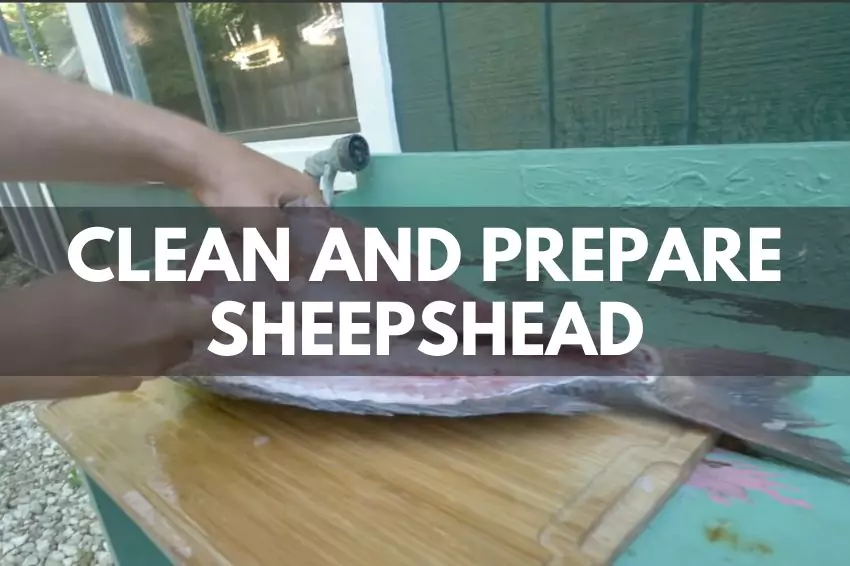Cleaning and filleting a sheepshead fish can seem daunting, but it can be a quick and easy process with the right tools and techniques.
Sheepshead is a popular game fish found in the coastal waters of the Atlantic Ocean and Gulf of Mexico. They are known for their sharp teeth and tough skin, making cleaning and filleting them tricky. However, with some practice, anyone can learn to do it like a pro.
Preparation Before Cleaning and Filleting
Cleaning and filleting a sheepshead fish can be messy and tricky. Still, with the proper preparation and tools, it can be done quickly and easily.
Here are some essential steps before cleaning and filleting a sheepshead fish.
Gathering Essential Tools
Before starting the cleaning and filleting process, gathering all the necessary tools is crucial. A fillet knife with a sharp blade is essential to remove the meat from the bones of the fish. A cutting board or flat surface for filleting should also be nearby.
Other essential tools include pliers or a fish scaler to remove the fish’s scales, scissors to cut the fins, and a bowl or bucket to hold the cleaned fish. It is also recommended to wear gloves to protect your hands from the sharp edges of the fish.

Detailed Steps to Clean Sheepshead Fish
Cleaning and filleting a sheepshead fish can be tricky, but it can be done quickly with the proper technique. Here are the steps to clean a sheepshead fish:
- First, rinse the fish with water to remove any dirt or debris. Pat it dry with a paper towel.
- Use a sharp fillet knife to cut the gills down to the backbone. Repeat on the other side of the fish.
- Make a cut along the backbone from the head to the tail. Use the knife to separate the flesh from the bones, starting at the head and working toward the bottom.
- Once you have removed the fillet, use the knife to remove the skin from the flesh. Hold the fillet with the skin side down and cut the skin and the flesh, angling the knife slightly downward.
- Repeat the process on the other side of the fish to remove the second fillet.
To clean the remaining fish:
- Use a spoon to remove the guts and other internal organs.
- Rinse the fish with water to remove any remaining blood or debris.
- Use a scaler or a knife to remove the scales from the skin.
- Use a pair of scissors to snip off the fins.
- Rinse the fish thoroughly with water again.
By following these steps, you can easily clean and fillet a sheepshead fish. Using a sharp fillet knife and working carefully is essential to avoid damaging the flesh. With practice, you can become an expert at cleaning sheepshead fish.
Guide to Fillet Sheepshead Fish
Sheepshead fish are known for their delicious meat, but cleaning and filleting them can be challenging. Here is a guide on how to fillet a sheepshead fish:
- Start by placing the sheepshead fish on a clean surface and cutting off its head. Use a sharp knife and cut behind the gills.
- Next, cut behind the pectoral fin and down to the backbone. Do the same on the other side of the fish.
- With the fish on its side, insert the knife blade under the fillet and cut towards the tail. Use the backbone as a guide and cut as close to it as possible.
- Once the fillet is removed, place it skin-side down and cut off the rib bones. Use a sharp knife and make minor, careful cuts along the rib bones.
- Repeat the process on the other side of the fish to remove the second fillet.
- Finally, use a pair of pliers to remove any remaining bones from the fillets. Run your fingers along the fillet to feel for any bones and remove them with the pliers.
It is essential to use a sharp knife when filleting a sheepshead fish. A dull blade can make the process more complex and result in a less desirable fillet. Additionally, make sure to clean your knife between cuts to prevent cross-contamination.
Following these steps, anyone can quickly learn how to fillet a sheepshead fish.
Tips for Perfect Filleting
When it comes to filleting sheepshead fish, a few tips can help ensure a perfect fillet every time. Here are some tips to keep in mind:
Avoiding Common Mistakes
One of the most common mistakes when filleting sheepshead is not using a sharp enough knife. A dull blade can make cutting through the fish’s skin and bones difficult, resulting in an uneven fillet. To avoid this, use a sharp fillet knife and hone it regularly.
Another mistake is not removing the skin properly. Sheepshead skin is tough and can be difficult to remove. Still, it’s essential to do so to avoid any unpleasant flavors. To remove the skin, make a small cut in the skin near the tail and grip it with a paper towel. Then, use a fillet knife to cut between the skin and the flesh, pulling the skin away as you go.
Maximizing Meat Yield
It’s important to know where to cut. The best place to start is just behind the gills, where the rib bones end. Cut down to the backbone, then turn the knife and cut along the spine towards the tail.
When cutting the fillet away from the rib bones, it’s essential to use a smooth, sweeping motion to avoid leaving meat behind. Keep the knife as close to the bones as possible to avoid wasting any meat.
Finally, remember to trim away any red meat or fat before cooking. This will result in a cleaner, more flavorful fillet.
By following these tips, anyone can become an expert at filleting sheepshead fish. With practice and patience, you can produce perfect fillets every time.
Preserving and Storing Sheepshead Fillets
Once you’ve successfully filleted your sheepshead fish, you’ll want to store the fillets properly to keep them fresh and flavorful. Here are some tips for preserving and storing sheepshead fillets:
Refrigeration
The best way to store sheepshead fillets is to refrigerate them. Wrap each fillet tightly in plastic wrap or aluminum foil and place them in an airtight container. You can also use a vacuum sealer to remove all the air from the packaging. Make sure to label the container with the date of storage.
Sheepshead fillets can last up to 2-3 days in the refrigerator. If you plan to keep them longer than that, consider freezing them.
Freezing
To freeze sheepshead fillets, wrap each fillet tightly in plastic wrap or aluminum foil or place them in a freezer-safe bag. Remove as much air as possible from the packaging to prevent freezer burn.
Sheepshead fillets can last up to 6 months in the freezer. If you plan to keep them longer than that, consider using a vacuum sealer to remove all the air from the packaging.
Thawing
When you’re ready to cook your sheepshead fillets, it’s important to thaw them properly. The best way to thaw frozen sheepshead fillets is to place them in the refrigerator overnight. If you’re short on time, you can also melt them in cold water or the microwave.
Avoid thawing sheepshead fillets at room temperature or in warm water, as this can cause bacteria to grow and spoil the fish.
Cooking
Sheepshead fillets can be cooked in various ways, including grilling, baking, frying, and broiling. Season the fillets with your favorite herbs and spices before cooking for added flavor.
When cooking sheepshead fillets, cook them to an internal temperature of 145°F (63°C) to ensure they’re safe to eat. Use a meat thermometer to check the temperature of the thickest part of the fillet.
Following these tips, you can properly preserve and store your sheepshead fillets and enjoy them at their best.
Here More:
How to clean croaker fish?
Clean and Cook guide of bowfin fish.
Visit foodjustify.com to discover more foods!





Leave a Reply
You must be logged in to post a comment.